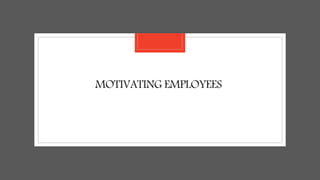Motivation
- 2. Outcome6: Understand how leaders motivate individuals and groups; identify, compare and contrast different motivation theories and understand how different scholars contributed to motivation within organization; ◦ Contents ◦ Meaning of Motivation ◦ Motivation Elements ◦ Importance of Motivation ◦ Types of Motivation ◦ Theories of Motivation
- 3. Introduction Motivation is the word derived from the word ’motive’ which means needs, desires, wants or drives within the individuals. Motivation is the process that initiates, guides, and maintains goal-oriented behaviors within the individuals. “Motivation means a process of stimulating people to action to accomplished desired goals” (William G. Scout)
- 4. Importance of Motivation Helps to change from negative attitude to positive attitude. Helps in reducing in employee absenteeism It helps the managers to introduce changes It improves performance level of employees. It helps in reduction in employee turnover. It creates supportive work environment It help in achieving the organizational goals
- 5. Elements of Motivation ◦ There are three major Elements of motivation: Activation involves the decision to initiate a behavior Activation Persistence is the continued effort toward a goal even though obstacles may exist. Persistence Intensity can be seen in the concentration that goes into pursuing a goal Intensity
- 6. Types of Motivation Types of Motivation Positive and Negative Motivation Intrinsic and Extrinsic Motivation Financial and Non Financial Motivation
- 7. Positive and Negative Positive motivation • Positive motivation induces people to do work in the best possible manner and to improve their performance. • Example : When Boss tells his subordinate , "if you achieve the target on the time I will give you promotion “ Negative motivation • Negative motivation purpose is to correct the mistakes of employees. • Example: When a Boss tells his subordinate , "if you do not achieve the target on the time I will give you demotion”
- 8. Intrinsic and extrinsic Intrinsic motivation • Intrinsic motivations are those that arise from within the individual • Example: Doing a complicated crossword puzzle purely for the personal satisfaction of solving a problem. Extrinsic motivation • Extrinsic motivations are those that arise from outside of the individual and often involve rewards. • Example: such as trophies, money, social recognition, or praise.
- 9. Financial and Non- Financial Financial motivation • Financial motivation involves motivating employees with money and things associated with money. • Example, increase in salary, allowances, performance related pay, profit sharing, bonus, Commission etc Non-Financial motivation • Non-financial motivation is an employee's encouragement without involving money. • Example recognition, Job Security, Job Enrichment:
- 11. Maslow’s Need Hierarchy Theory of Motivation ◦ Abraham Maslow is well renowned for proposing the Maslow’s Hierarchy of Needs Theory in 1943. ◦ Maslow was of the view that needs have priority, i.e., needs are satisfied in an order. ◦ As soon as the lower level needs are satisfied. Those on the next higher level need emerge. ◦ Thus, he considered an individual's motivation behavior as a predetermined order of needs Abraham Maslow
- 12. Maslow’s Need Hierarchy Theory of Motivation
- 13. ◦ Physiological needs- These are the basic needs of air, water, food, clothing and shelter. In other words, physiological needs are the needs for basic amenities of life. ◦ Safety needs- Safety needs include physical, environmental and emotional safety and protection. For instance- Job security, financial security, protection from animals, family security, health security, etc. ◦ Social needs- These needs emerge from society. Man is a social animal. These needs become important. Social needs include the need for love, affection, care, belongingness, and friendship. ◦ Esteem needs- Esteem needs are of two types: internal esteem needs (self- respect, confidence, competence, achievement and freedom) and external esteem needs (recognition, power, status, attention and admiration). ◦ Self-actualization need- This include the urge to become what you are capable of becoming / what you have the potential to become. It includes the need for growth and self-contentment. It also includes desire for gaining more knowledge, social- service, creativity and being aesthetic.
- 14. McGregor :Theory X and Theory Y ◦ In 1960, Douglas McGregor formulated Theory X and Theory Y suggesting two aspects of human behavior at work. According to McGregor, the perception of managers on the nature of individuals is based on various assumptions. DOUGLAS MCGREGOR ASSUMPTIONS
- 16. Herzberg's Two-factor Theory ◦In 1959, Frederick Herzberg propose two- factor theory (also known as Herzberg's motivation-hygiene theory). ◦Herzberg’s two-factor theory outlines that humans are motivated by two things: ◦Hygiene factors ◦Motivators factors Frederick Herzberg's
- 17. Hygiene factors • Hygiene factors: factors that are not related to workplace satisfaction but must be present in the workplace in order to prevent dissatisfaction. • Hygiene factors cover extrinsic needs such as pay grade, workplace policy and relationships with their peers. Motivation factors • Motivation factors: factors that are related to workplace satisfaction. They cover intrinsic needs such as achievement, recognition, and advancement. • Motivation factors allow employees to be content in their jobs and promote growth
Editor's Notes
- https://www.valamis.com/hub/types-of-motivation
- https://www.valamis.com/hub/types-of-motivation
- https://www.valamis.com/hub/types-of-motivation
- https://www.valamis.com/hub/types-of-motivation

